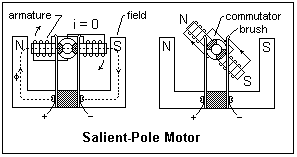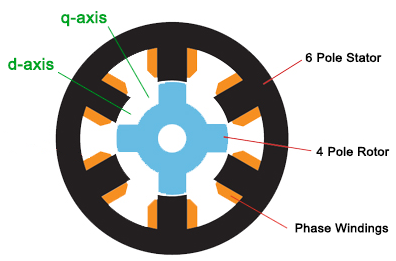
Practical Coilgun Design
Magnetic Materials
- Magnetic Materials
- Solenoid Physics
- Magnetic Field
- Force From Magnetism
- Saturation
- Saliency Ratio
- Salient Pole Motors
- Electromagnetic Guns
- Widescreen LCD
- IEEE Articles
- Bibliography
Saliency Ratio
What makes a good coilgun? Some good clues can be taken from those who design rotary reluctance motors. Let's describe saliency ratio - a concept so basic and widely used in motor design that it is seldom defined.
Saliency Ratio
 The
term "salient" refers to visible, or exposed, or sticking out. So a "salient pole
motor" is one which exposes the N and S poles to the rotor.
The
term "salient" refers to visible, or exposed, or sticking out. So a "salient pole
motor" is one which exposes the N and S poles to the rotor.
"Saliency ratio" applies equally well to both permanent magnet synchronous motors (PMSMs) and switched reluctance motors (SRMs). And it applies to poles from a permanent magnet, or generated by an electromagnet.
"saliency ratio" = Ld / Lq
Ld = inductance in d-axis
Lq = inductance in q-axis
 The d-axis is
when the rotor is aligned with the poles. It is also the orientation with highest inductance.
The d-axis is
when the rotor is aligned with the poles. It is also the orientation with highest inductance.
The q-axis is when the rotor is aligned with the gaps. It has the lowest inductance.
It can be shown that reluctance motors work best when you maximize the saliency ratio.
In other words, a good figure of merit is to measure the maximum and minimum inductance in your drive coil. You can compare this coil's saliency ratio with another coil, and have a good estimate of their relative performance. And you don't even need to fire the coilgun!
References
- Peng Zhang, Dan Ionel, Nabeel Demerdash, Saliency Ratio and Power Factor of IPM Motors Optimally Designed for High Efficiency and Low Cost Objectives, 2016
| < Previous | Page 6 of 11 | Next > |
©1998-2025 Barry Hansen